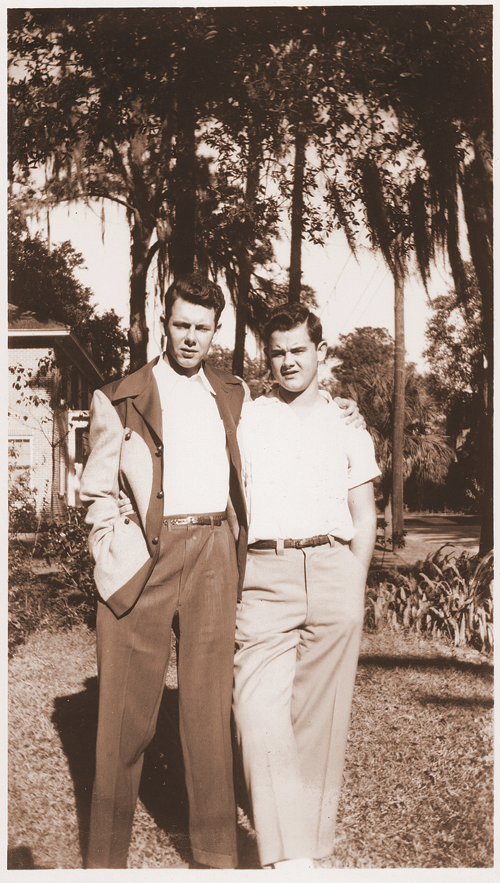Tommy Madison
Standing in his glass enclosed river room high above the St. Johns, Tommy Madison looks like a captain on the bow of his ship. His Beau Rivage view encompasses the skyscrapers of Downtown and sweeps south to the Naval Air Station. His personal geography is spread out below him.
“I was born in 1931 and grew up behind the Avondale shopping Center at 3557 Pine Street,” he reminisces. “My parents built the house in 1925 and lived in it until they passed away in 1977 and 1991 respectively.
“Next door to our house was the original farm house for the area. To accommodate the shopping center an alley ran from Talbot to Shadowlawn and at some point the farm house was actually divided into two pieces and moved apart. One part of the house which faced St. Johns was made into two apartments and the other which faced Pine Street was kept single family.
“Of course there was no air conditioning in our house. My brother Bill and I would sometimes sleep on the sun porch and at other times it would be so hot that we would put our pillows in the bedroom windows. After WWII window air conditioners appeared to make things cooler. For heat there was the coal fired furnace which was later converted to fuel oil.
“The Depression influenced everyone’s life. People shared food and friendship. Nobody had any extra money for toys, so creativity was really important. Down at the grocery store most of the produce came in wooden crates and these could be converted into go carts that could zoom down the hills in our neighborhood. Because the carts had no really functional brakes, we were lucky there were almost no cars on the streets. Gas was rationed.
“To show how serious the rationing was, in 1942 a car was hit and flipped over at the end of my street. After one of my neighbors made certain the driver of the car was O.K., he noticed that gas was dripping out of her car’s tank. He ran home and got a can to save the gas for his own car. Fuel was a precious commodity.
“When we weren’t building carts, we spent lots of time playing at White Sands which was a place at the end of Talbot where the sand had been pumped in before the Florida Boom. Everyone gathered there. Mothers would take us as little guys with buckets and shovels. Later on we would play pickup football there and sometimes fish or shrimp there, too.
“Also on Talbot between Pine and Hedrick there was a concrete road with expansion joints that were patched with tar. When it got really hot, the tar would ooze into a slick at the bottom of the hill especially at the curb. This made a great place to ride our bikes and slide sideways at the bottom to stop if we put out our left foot. It was especially slick after a light rain when covered with leaves. Mike Kelly was a new kid and we didn’t tell him about the left foot braking part. He zoomed down the hill and went into a big slide and then crashed. We left the scene. He wasn’t hurt, which was a good thing, and he didn’t try to hurt any of us which he could have done because he was about three inches taller than any of us.
“The entire neighborhood was open for all of us. No one locked the doors. At the foot of Ingleside and Richmond Street there was a place that was perfect for neighborhood kids. Mrs. Hubbard had a tennis court there that she kept up for us. Sometimes she would bring out pitchers of ice water if it was hot. Down on the river, the McIlvanes who had grown children and several boats actually let us sail the 12-foot one. My love of sailing stems from that experience. Outside the neighborhood, there were trips to Fernandina with Jack Hines where we drove autos on the beach.
“Moving through Fishweir, Gorrie, and Lee, I raised my spending money to buy a bike in a variety of ways. I sold gladiolas which Mr. Triplett brought from his farm. I mowed lawns with a push mower and worked in the produce department at the A&P grocery store on Herschel. Later on, I ran errands at Bisbee Baldwin Insurance and worked as a machinist helper at the Merrill Stephens Shipyards, a physically demanding job that had me crawling deep into the bilge of a variety of vessels carrying boxes of tools but provided college cash.
“After college at Washington and Lee, I graduated from Navy Officer Candidate School, served three years in the Navy and married Julie Russell in 1955. Actually, Julie was one of the little girls I shot chinaberries at from my bamboo blowgun so many years ago. We have two sons, Marshall and Baker. We also have five grandchildren.
“In 1957, I joined Florida Machine Foundry Company and had a fascinating career. Our family lived seven years in Venetia, 33 years in Ortega and in 1997 Julie and I moved to the Beau Rivage which is within one half mile from my old homestead. Indeed, reflecting on my Avondale upbringing during the Depression and WWII, I realize it taught me the value of money, community and hard work. It is good to be back.”
Indeed, one leaves the presence of Tommy Madison feeling that his future harbors voyages of learning still to come. And because he is a vivid storyteller, one can stand on his river porch and imagine him as young man sailing a sailboat made of grocery carton wood far out on the bright blue St. Johns.







